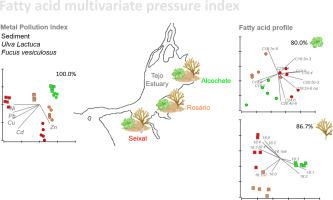Science of the Total Environment ( IF 8.2 ) Pub Date : 2021-05-17 , DOI: 10.1016/j.scitotenv.2021.147817 Bernardo Duarte 1 , João Carreiras 2 , Eduardo Feijão 2 , Patrick Reis-Santos 3 , Isabel Caçador 1 , Ana Rita Matos 4 , Vanessa F Fonseca 5

|
Transitional ecosystems are among the most degraded ecosystems worldwide, with several groups of organisms investigated for their reliability as biological indicators of human-driven disturbances. Recently non-traditional biochemical biomarkers such as an individual's fatty acids profile have been identified as promising tools for assessing contaminant exposure. In this work, two abundant Atlantic benthic macroalgae (Ulva lactuca and Fucus vesiculosus species) were surveyed in three mudflat areas of the highly urbanized Tejo estuary, with increasing anthropogenic disturbance degrees (Alcochete, Rosário and Seixal mudflats, increasing in contamination by this order) and their fatty acids evaluated as potential biomarkers for exposure to contaminants known to have toxic effects on biota. In terms of contamination the metal pollution index of all the compartments analysed (sediment bioavailable and total metal concentrations and thallus metal concentrations) revealed the same tendencies with lower contamination levels in Alcochete, intermediate in Rosário and high contamination levels in Seixal. In the thallus of U. lactuca thallus could be observed a strong decrease in C18-fatty acids along the contamination gradient, likely due to lipid peroxidation from metal-generated reactive oxygen species. Nevertheless, an increase in stearic and hexadecatrienoic acids in the thallus from the most contaminated site suggested counteractive mechanisms maintain the production of C18-fatty acid pool. A similar response was found in F. vesiculosus but with palmitic acid acting as precursor for the synthesis of stearic acid, allowing the maintenance of oleic and linoleic acids levels in the membranes to counteract oxidative stress. Beyond the physiological interest of these mechanisms, fatty acid profiles were used to develop a novel multivariate pressure index (Multi-PI), that beyond the contaminant concentration would reflect the response of these biomonitor species towards anthropogenic disturbance, through the evaluation of fatty acid profiles, which are also key molecules from a trophic perspective within the estuarine system. The Multi-PI efficiency in responding to different environmental contamination degrees, was substantiated by strong and positive correlations with thallus and sediment contamination. This indicated that fatty acid profiles reflect thallus and benthic habitat contamination and are efficient biomarkers of environmental metal contamination. Therefore, the sessile and abundant nature of benthic macroalgae allied to their fatty acid responses can be leveraged as suitable biomarkers for contaminant monitoring in future impact assessment and ecotoxicology studies.
中文翻译:

河口大型藻类的脂肪酸谱是人为压力的生物标记:07a多元压力指数的开发和应用
过渡性生态系统是世界上退化最严重的生态系统之一,已对几类生物体作为人类驱动的干扰的生物学指标进行了可靠性研究。最近,非传统的生化生物标记物(例如个人的脂肪酸谱)已被鉴定为评估污染物暴露的有前途的工具。在这项工作中,两个丰富的大西洋底栖大型藻类(Ulva lactuca和Fucus vesiculosus在高度城市化的Tejo河口的三个滩涂区域中进行了调查,其中人为干扰度不断增加(Alcochete,Rosário和Seixal滩涂,按此顺序增加了污染),其脂肪酸被评估为潜在的生物标志物,暴露于已知的污染物对生物群的毒性作用。就污染而言,分析的所有舱室的金属污染指数(沉积物的生物利用度以及总金属浓度和th金属浓度)都显示出相同的趋势,其中Alcochete的污染水平较低,Rosário的中等水平,而Seixal的污染水平较高。在U. lactuca的all中可以观察到,由于金属生成的活性氧物种引起的脂质过氧化作用,C18-脂肪酸沿污染梯度急剧降低,从而使牛传染。然而,受污染最严重的部位的all体中的硬脂酸和十六碳三烯酸增加,这表明反作用机制维持了C18-脂肪酸库的产生。F. vesiculosus发现了类似的反应但棕榈酸作为硬脂酸合成的前体,可以维持膜中油酸和亚油酸的水平以抵消氧化应激。除了这些机制的生理学意义外,脂肪酸谱还用于建立新的多元压力指数(Multi-PI),该指数超出了污染物浓度,将通过评估脂肪酸谱反映出这些生物监测物种对人为干扰的响应从营养学的角度来看,它们也是河口系统中的关键分子。Multi-PI响应不同环境污染程度的效率通过与all气和沉积物污染的强正相关而得到证实。这表明脂肪酸谱反映了all和底栖生境污染,是环境金属污染的有效生物标志物。因此,与它们的脂肪酸反应相关的底栖大型藻类的固执和丰富的性质可以作为合适的生物标记物用于未来的影响评估和生态毒理学研究中的污染物监测。











































 京公网安备 11010802027423号
京公网安备 11010802027423号